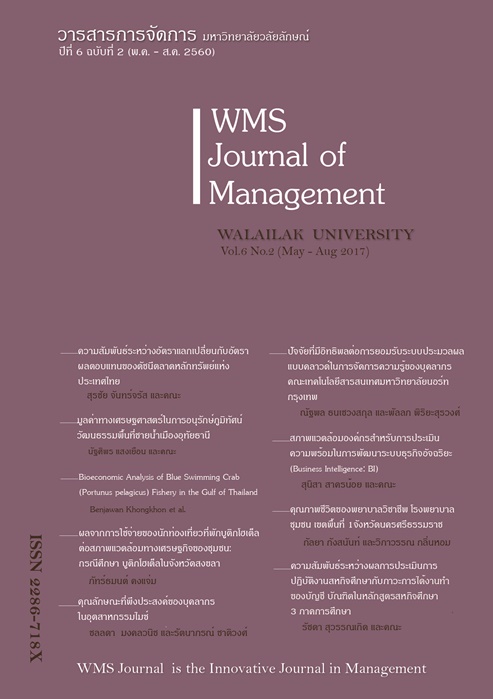Organizational Environment for Business Intelligence Readiness Evaluation
Main Article Content
Abstract
This research is aimed to study the factor for evaluating the readiness of the independent public agency in Thailand in term of its environment whether it is ready for business intelligence system. The research process consists of six stages: 1) the review of the literature and relevant studies, 2) development of conceptual model and research model, 3) development of data collection tool, 4) the conduction of empirical research where the data collected from the questionnaires, 5) the analysis of research data by using statistical technique; namely, Exploratory Factor Analysis (EFA) and Confirmatory Factor Analysis (CFA) and 6) research conclusion. The population of this study is the staff who are working in the case company. There are altogether 1,258 people from 28 departments. The sample size is 297.
The findings found that organizational factor for evaluating the readiness of the organization for business intelligence system can be classified into four dimensions as 1) human capital, 2) knowledge process, 3) organizational culture, and 4) IT infrastructure. The readiness in the dimensions of knowledge process and IT infrastructure is considerably high while the dimensions of human capital and knowledge process are at fair level. The inequality of the readiness in each dimension can be the obstacle for developing business intelligence system. Therefore, the executives must focus on the importance of policies to be laid in the aspects of improving the dimensions of human capital and organizational culture which hence lead to the success of the organization afterwards.Article Details
References
การจัดลำดับเทคโนโลยียอดนิยม 10 อันดับ ที่องค์กรนำเข้ามาใช้งานปี 2013. สืบค้นเมื่อวันที่ 18 ธันวาคม 2557, สืบค้นจากhttp://www.gartnerinfo.com/sym23/evtm_219_CIOtop10%5B3%5D.pdf.
ธานินทร์ ศิลป์จารุ (2555). การวิจัยและการวิเคราะห์ข้อมูลทางสถิติด้วย SPSS และ AMOS. พิมพ์ครั้งที่ 13. กรุงเทพฯ: ห้างหุ้นส่วนสามัญบิสอาร์แอนด์ดี จำกัด.
วิทยา พรพัชรพงศ์. 2549. Business Intelligence คืออะไร มีประโยชน์ต่อธุรกิจอย่างไร. สืบค้นเมื่อวันที่ 4 พฤศจิกายน 2557, สืบค้นจาก https://www.gotoknow.org/posts/52660.
วิเชียร เปรมชัยสวัสดิ์. 2551. ระบบสารสนเทศเพื่อการจัดการ. พิมพ์ครั้งที่6. กรุงเทพมหานคร: ซีเอ็ดยูเคชั่น.
สาเหตุปัญหาที่ทำให้การนำ BI เข้ามาใช้งานองค์กรประสบความความล้มเหลว จากผลการวิจัยของ Gartner, 2013. สืบค้นเมื่อวันที่ 5 มกราคม 2558, สืบค้นจาก http://www.gartner.com/technology/home.jsp.
Armstrong, C. P., & Sambamurthy, V. 1999. Information technology assimilation in firms: The influence of senior leadership and IT infrastructures. Information systems research, 10(4), 304-327.
Bhatti, T. R. 2005. Critical success factors for the implementation of enterprise resource planning (ERP): empirical validation. In the second international conference on innovation in information technology (ITT’5), p. 1-10. Dubai, UAE.
Bruque, S., & Moyano, J. 2007. Organisational determinants of information technology adoption and implementation in SMEs: The case of family and cooperative firms. Technovation, 27(5), 241-253.
Davis, J., Miller, G. J., & Russell, A. 2006. Information revolution: using the information evolution model to grow your business. New Jersey:John Wiley & Sons.
Drucker, P. 1998. The Next Information Revolution. สืบค้นเมื่อวันที่ 4 พฤศจิกายน 2557, สืบค้นจาก http://www.forbes.com/asap/98/0824/046c.htm accessed March 2002.
Eckerson, W. 2003. Smart companies in the 21st century: The secrets of creating successful business intelligence solutions. TDWI The Data Warehousing Institute Report Series, 1-35. Seattle: MicroStrategy, Inc.
Fink, D. 1998. Guidelines for the successful adoption of information technology in small and medium enterprises. International journal of information management, 18(4), 243-253.
Geiger, J. 2006. Managing the Business Intelligence Infrastructure. DM review, Intelligence Solution. สืบค้นเมื่อวันที่ 9 มกราคม 2558, สืบค้นจาก http://www.intelsols.com/documents/2006-07%20Geiger.pdf.
Lunneborg, C. E. 1979. Book Review: Psychometric Theory: Secon d Edition Jum C. Nunnally New York: McGraw-Hill, 1978, 701 pages. Applied Psychological Measurement, 3(2), 279-280.
Markovic, N. 2010. Business Performance Measurement and Information Evolution Model. In Proceedings of the 4th European Conference on Information Management & Evaluation (pp. 257-264).
Mirvis, P. H., Sales, A. L., & Hackett, E. J. 1991. The implementation and adoption of new technology in organizations: the impact on work, people, and culture. Human Resource Management, 30(1), 113-139.
Peppard, J., & Ward, J. 2004. Beyond strategic information systems: towards an IS capability. The Journal of Strategic Information Systems, 13(2), 167-194.
Powell, T. C., & Dent-Micallef, A. 1997. Information technology as competitive advantage: the role of human, business, and technology resources. Strategic management journal, 18(5), 375-405.
Reinschmidt, J., & Francoise, A. 2000. Business intelligence certification guide. IBM International Technical Support Organisation.
Robert V. K. & Earyle W. M. 1970. Determining Sample Size for Research Activities. Education and Psychological Measurement, 30(3), 607 – 610.
Scott, M.S. 1991. The Corporation of the 1990s: Information Technology and Organizational Transformation. New York: Oxford University Press.
Tarokha, M. J., & Teymournejada, E. 2012. USING ASSOCIATION RULES FOR EVALUATING AND PREDICTING RISK FACTORS IN BUSINESS INTELLIGENCE SYSTEM. Business Intelligence Journal (19182325), 5(2).
Turban, E., Aronson, J.E., Liang, T. & Sharda, R. 2007. Decision Support Systems and Business Intelligence Systems. 8th ed. Prentice Hall, Pearson Education International. สืบค้นเมื่อวันที่ 19 กุมภาพันธ์ 2558, สืบค้นจาก http://www.cs.ubbcluj.ro/~per/Dss/Dss_1.pdf.
Vijayan, J. 2012. Finding the business value in big data is a big problem (September 12). CIO.com. สืบค้นเมื่อวันที่ 19 กุมภาพันธ์ 2558, สืบค้นจาก http://www.cio.com/article/716102/Finding_the_Business_Value_in_Big_Data_is_a_Big_Problem.
Watson, H. J., Fuller, C., & Ariyachandra, T. 2004. Data warehouse governance: best practices at Blue Cross and Blue Shield of North Carolina. Decision Support Systems, 38(3), 435-450.
Williams, S., & Williams, N. 2007. The profit impact of business intelligence. San Francisco: Morgan Kaufmann.
Wixom, B., & Watson, H. 2010. The BI-based organization. International Journal of Business Intelligence Research (IJBIR), 1(1), 13-28.


